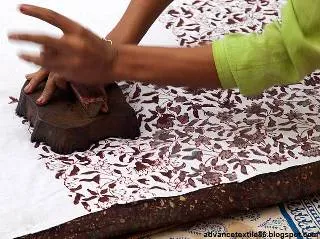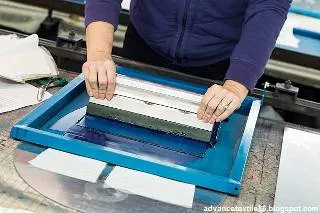Printing
Printing
is the process of arranging textile fabrics in the form of patterns of
pigments, dyes, or other related materials. Although the fabric evolved from
hand painting, such methods are also ancient antiquity. There is evidence of
printing in India in the 4th century BC and the printing block was found in the
tomb of Akhmin in Upper Egypt around 300 AD.
Textile printing
Textile printing is a technique of applying color to specific patterns or designs that
are properly attached to the fabric. It is related to dyeing but in the case of
proper dyeing, the whole fabric is evenly covered with one color, whereas in
printing one or more colors are applied only to specific parts and to highly
defined patterns. During printing, wooden blocks, stencils, engraved plates,
rollers, or silkscreens can be used to dye the fabric. Colors used in printing
are thickened to spread the color by the attraction of rays beyond the
boundaries of any pattern or design.
History of Textile printing
Textile
printing history was known in Europe through the Islamic world from about the twelfth
century and it was widely used. However, European dyes tended to be liquid,
which limited the use of printed patterns. Quite large and ambitious designs
were printed for decorative work such as wall-hanging and lacquer-cloth, where
it was less of a problem as they needed to be washed. As paper became more
common, the technology was quickly used to print wood cuttings. The higher
fabric was also imported from Islamic countries, but it was more expensive.
In the last half of the seventeenth century, the French were brought directly by
sea from their colonies to the east coast of India, resisting the Indian blue
and white specimens and giving details of the processes they created alongside
them to produce washable cloth. From an artistic point of view, most of the
pioneering work of Calico printing was done by the French. From the earliest
days of art until the last half of the twentieth century, the productions of
French printers Jouy, Beauvais, Rouen, and Alsace-Lorraine, were considered the
best in the field of artistic calico printing.
Methods of textile printing
There
are mainly four methods of textile printing as block, roller, screen, and
heat transfer printing. In each of these methods, the dye is applied, usually
as a thick paste, after stabilization, usually by steaming or heating and then
washing to remove excess dye. These are below-
Block printing
The block printing process is the simplest, easiest, and slowest of all printing
methods. A design is painted, or transferred to ready wooden blocks for
printing. Each individual color in the design requires a separate block. A
block cutter first builds wood around heavy masses, leaving finer and more
delicate work to the end to avoid any risk of damage to it when cutting thicker
parts. When finished, the block has the appearance of a flat relief carving, and the design stands out. The finer details, solid cut in wood, are built into
strips of brass or copper, which are curved in shape and driven towards the flat
surface of the block at the edges. This method is also called coppering.
Roller printing
The Roller printing technique is used whenever long runs of fabric are printed with
the same design. The modern machine consists of a large central cast-iron
cylinder based on the one originally built-in 1783. A dense endless blanket
provides stable support for the fabric to prevent unwanted stains on the
blanket. Although previously made with cotton fabric, most modern back greens
consist of a continuous nylon belt. The back blanket and gray are properly
stimulated so that the fabric passes through the machine as the central
cylinder rotates. Engraved printing rollers, one for each color, press against
the fabric and the central cylinder. The pattern on the top of the roller is
arranged on the surface of a copper shell supported on a mandrel. High-quality
engraving is essential for good printing each printing roller is supplied with
a rotating color-decorated roller, partially immersed in a hole in the print
paste.
Screen printing
Screen printing can be a hand operation or an automatic machine process. The fabric is
first placed on a printing table, rolled in place, or pinned in gray on the
back, and then the design is applied to a wooden or metal frame with a screen
made of stretched silk or nylon gauge, on which the design for color is
reproduced. Done. This is normally a photographic process, even though hand
painting options with suitable resistant blocking paint. A screen is placed on
top of the fabric on the table against the registration stop to ensure perfect
pattern fitting. The printing paste is poured on the edge of the screen to the
operator and it is spread on the surface of the screen so that the color is
pushed through the open parts. The screen is removed until the color is applied
to the fabric. For the implementation of other colors, the technique is
repeated with different screens.
Transfer printing
Transfer
printing is a method using copper or steel plates engraved in pottery or any
other material from which a monochrome print is taken on paper that is
transferred by pressing on a piece of ceramic. The process is used to make
engraving or etching on paper in the same way as engraved metal printing
plates. Plates are used to print patterns on tissue paper, mixtures of special
pigments that stand as “ink” until shot. The transfer pigment side is then
placed on a piece of pottery at the bottom so that the sticky ink transfers to
the ceramic surface. Typically, a separate transfer section was required for
each piece if the design covered the entire object. The piece of paper is
either soaked in water or fired, or it burns during the firing. This can be
done on or under ceramic glass but the underglaze method gives a much more
durable decoration. The ceramic is then polished and shot in one fell swoop to
fix the pattern. With overglaze printing, only low-temperature shots need to
be fired. The process creates fine lines similar to engraved prints.














0 Comments